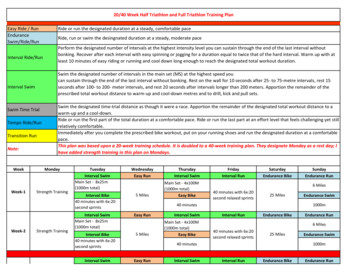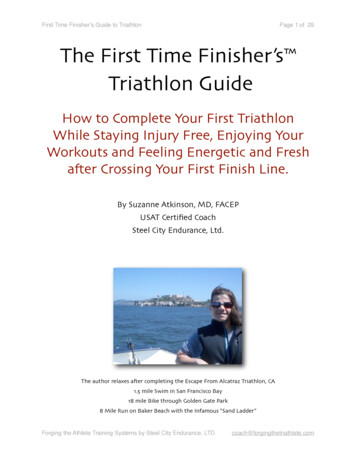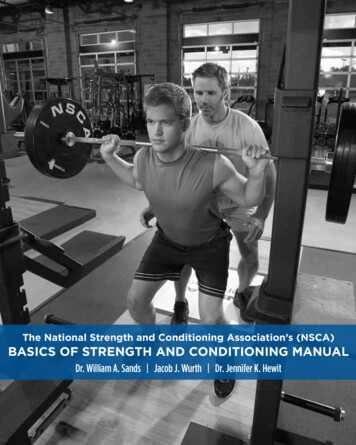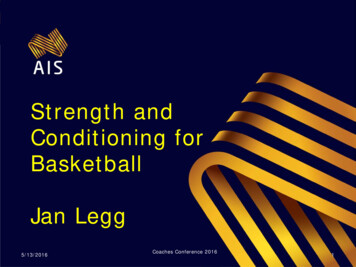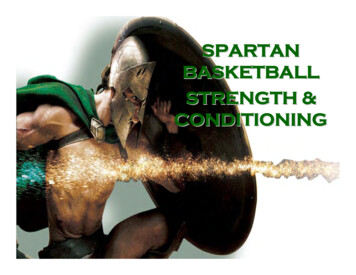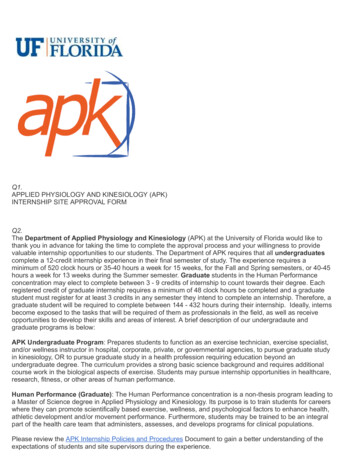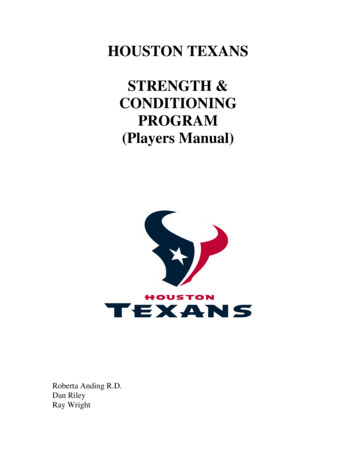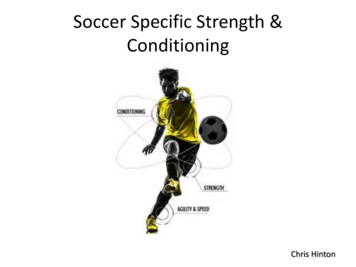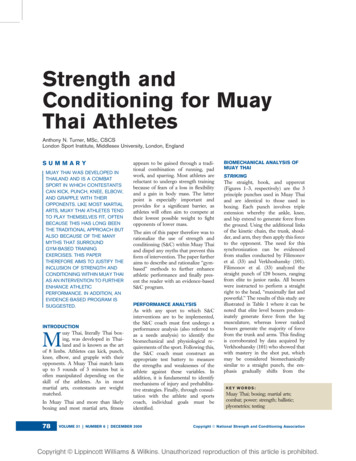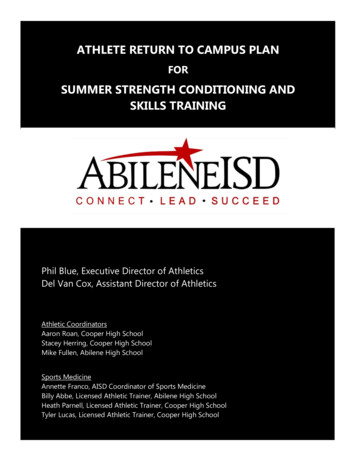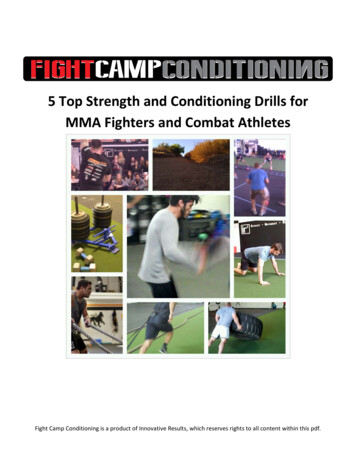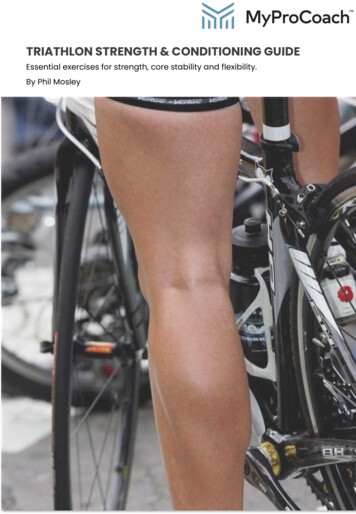
Transcription
TRIATHLON STRENGTH & CONDITIONING GUIDEEssential exercises for strength, core stability and flexibility.By Phil Mosley1
Strength and Conditioning for TriathletesUsing This GuideYour training plan in Training Peaks includes one or two Strength workouts per week. Click onthose workouts to see which exercises you should do on a given day. Then refer back to this PDFwhen you need guidance on how to perform each exercise.Exercise InstructionThis guide provides written descriptions of each exercise. Which muscles you are targeting and why. Aswell as tips, how to progress and alternatives. There are useful videos and images that show you whatyou need to do. You can adapt and progress sessions gradually according ability and experience.Click to view all the Strength and Conditioning Videos included in this PDF.(Save the playlist to your YouTube library for future reference).Why Do Strength And Conditioning?We have chosen specific strength and flexibility exercises to support your swim, bike and run training.They are designed to increase power, range of movement, coordination, flexibility, agility, strength andstability providing you with a solid internal ‘scaffold’ to support all aspects of your training. You willimprove your efficiency and boost your performance.Injury PreventionIncluding strength and conditioning will help minimize the risks of injury through improved strength,stability and by matching imbalances that can be created by repetitive overuse.What Equipment Do I Need?All exercises (or alternatives) can be done at home with a mat, dumbbells and/or band. Or in the gymusing machines (where given as an alternative) and/or the free weights area.When Should I Do Strength Workouts?There are one or two strength workouts each week. If you have another workout scheduled on yourstrength day you should do the triathlon specific discipline first. When switching things around in yourcalendar be conscious of workouts that follow your strength sessions.How Will Strength Sessions Fit With My Triathlon Plan? Prep Phase: Develop neuromuscular efficiency, stability and functional strength. Base Phase: Build a foundation that can be used for power development. The goal is totranslate strength training into sport-specific activity. Build Phase: Develop power, balance and neuromuscular control. Form is key, reduce theintensity if you cannot hold your form. Peak Phase: Allows you to focus on sport-specific training. This means decreasing the stress ofa strength and conditioning training session by reducing intensity and volume.FlexibilityThere are six key flexibility exercises included. Select stretches that are specific to your requirements,the ones described within this document are a guide. You may have some favorites that work well foryou.2
Strength and Conditioning for Triathletes1. SQUATWorks: Glutes, hamstrings and quads.Why: Generates strength, power and stability for pedaling and running.1.Stand with your feet shoulder-width apart and pointing straight ahead, arms at your sides.2.Initiating the move with your hips, squat back and down until your thighs are parallel to thefloor.3.Return to a standing position by pushing through your hips.Tips: Keep your chest up, back flat, and do not let your knees collapse to the inside.Progressions: Add weights, squat jumps.Alternatives: Smith machine, leg press machine, goblet squat.2. SQUAT JUMPWorks: Glutes, hamstrings and quads.Why: Boosts explosive power, for running and cycling.1.Stand with feet just outside of shoulders.2.Sit back and down into squat position, keeping knees behind toes.3.Immediately jump vertically by extending through hips and swinging arms for propulsion.4.Land softly in squat position with hips back and down. Immediately repeat the samemovement.Tips: Keep chest up during the jump. Extend hips completely during jump.Progressions: Increase reps, reduce rests.Alternatives: Any low impact weighted squat variations, leg press, box jumps.3
Strength and Conditioning for Triathletes3. SINGLE LEG SQUATWorks: Glutes, hips, hamstrings, calves and quads.Why: Strengthen your force producing muscles and improve power for the run and bike.1.Stand on one foot with your other leg bent at the knee.2.Once you’re balanced on one leg, squat down as low as you can without losing your form (ortoppling over). Don’t let your standing knee go past the front of your toes while you squat.3.Pause at the bottom of the squat for a second, then push back up through your heel,squeezing your glutes as you go.Tips: Hold both arms out in front of you during the exercise to help keep your balance.Progression: Hold raised leg straight out in front (pistol squat), increase reps.Alternatives: Bulgarian squat, alternate lunges.4. BULGARIAN SQUATWorks: Glutes, hamstrings and quads.Why: Strength, balance and core control.1.Find yourself anything stable that you can rest a foot on, it needs to be about knee height.2.Get into a forward lunge position with torso upright, core braced and hips square to yourbody, with your back foot elevated on bench. Your leading leg should be about half a metrein front.3.Lower until your front thigh is almost horizontal, keeping your knee in line with your foot.4.Drive up through your front heel back to the starting position, keep your movementsmeasured. Repeat your reps on one leg before switching sides.Tips: Don't let your front knee travel beyond your toes. Keep your torso upright.Progressions: Add weight, increase reps, reduce rest.Alternatives: Single leg squat, pistol squat, single leg press.4
Strength and Conditioning for Triathletes5. ALTERNATE LUNGEWorks: Glutes and quads.Why: Increase strength, power and stability for pedaling and running.1.Start with your feet about shoulder width apart, standing tall with your core engaged.2.Step forward into lunge and lower until you reach approx. 90 degrees at both knees.3.Push your body back up to the starting position through your front heel, switch legs andrepeat. 1x right and 1x left is one rep.Tips: Don’t extend the front knee past your toes. Keep your torso upright.Progression: Add weight, increase reps, reduce rest, make this exercise dynamic by adding jumpswitch.Alternatives: Squats, leg press, step ups, reverse lunges6. REVERSE LUNGEWorks: Glutes, hamstrings, calves and quads.Why: Driving back to the starting position mimics the running movement.1.Stand upright, core tight.2.Take a big step backwards with your left foot and lower until both knees are at 90 degrees.3.Push back up and return to starting position. Repeat with right leg. This is one rep.Tips: Keep your torso upright and focus to stay balanced.Progression: Add weight, increase reps, reduce rest.Alternatives: Alternate lunges, step ups, squats, leg press.5
Strength and Conditioning for Triathletes7. STEP UPWorks: Quads and hamstrings.Why: Build leg strength, power, flexibility and cardiovascular abilities.1. Stand facing the step or box.2. Place right foot on the step and stand up onto the step by extending the hip and knee of theraised right leg. Place both feet onto the platform.3. Step back down with the left leg. Switch sides and repeat with left leg leading. This is one rep.Tips: Keep your chest up throughout the movement.Progression: Add weight (dumbbells, weight vest or barbell), heighten step, add power by adding ahop as you step up.Alternatives: Alternate lunges, reverse lunges.8. CALF RAISEWorks: Calves.Why: Improve strength and stability, power the push off in running and prevent injury.1.Stand tall, core engaged.2.Push through the balls of your feet and raise your heel until you are standing on your toes.3.Slowly lower to return to your starting position.Tips: Don’t rush!Progression: Add weight (hold dumbbells), perform on a step to enable you to drop the heel lower.Alternative: Farmer’s walk on toes (walk holding dumbbells on toes).6
Strength and Conditioning for Triathletes9. HIGH KNEESWorks: Cardio, glutes, hamstrings and quads.Why: A cardio exercise that improves power, stability, flexibility and running form.1.Begin standing tall, core engaged and ready to jog in place.2.Flex the hip and bring your right knee towards your belly button, aim for your thigh to beparallel with the floor. As the right leg comes down lift the left knee. Ix right plus 1x left is 1 rep.Tips: Pump your arms. Stay dynamic and strong throughout. Keep your knees high.Progression: Increase duration.Alternatives: Step up with hop, skipping with rope, jump squats.10. BOX JUMPWorks: Quads, calves and hamstrings.Why: Explosive lower body power for strength and speed.1.Stand in front of the box with feet directly under the hips, hands by your side.2.Bend your knees and hips. Explosively jump up from the crouched position, swing your armsto help.3.Land softly on the center of the box, absorbing impact with your legs.4.Stand tall. Jump or step back to the starting position. Repeat.Tips: When starting out choose a low box or step, stop when your form and speed arecompromised.Progression: Use a higher box/platform.Alternatives: Squat jumps, step ups.7
Strength and Conditioning for Triathletes11. LATERAL AND FRONT RAISE COMBOWorks: Deltoids.Why: Strengthen shoulders and upper body. Prevent swimming injuries. Arm drive when running.1.Stand with your feet hip-width apart and hold core tight. Hold dumbbells in each handpalms facing each other.2.Raise dumbbells to sides until arms are parallel to ground, lower to start position.3.Turn hands so palms face back, raise dumbbells in front until arms are parallel to floor,lower to start position.4.1 lat and 1 front raise is one rep. Repeat.Tips: Keep your core tight and elbows soft, don’t swing the weights, stay in control.Progression: Increase weights, increase reps, reduce rest.Alternatives: Using an exercise band, cable machine, lat raise machine.12. BENT OVER ROWWorks: Lats, rhomboids, scapular stabilizers, shoulders, biceps, spinal erectors, glutes andhamstrings.Why: Strengthens back and core stabilizers for swimming, and postural endurance on your longrides and runs.1.Bend knees slightly and hinge at the hip keeping your back straight. Hold bar or dumbbells(palms facing back).2.Keep upper body stationary and pull weights to the torso and pause.3.Return to starting position controlling the movement throughout.Tips: Hold core tight throughout.Progression: Increase weight.Alternatives: Use band, lat pulldown, seated rows, inverted rows.8
Strength and Conditioning for Triathletes13. PUSH UPWorks: Pectorals, shoulders, triceps and core.Why: Upper body strength for swimming. Support on the bike and power your arms for the run.1.Lie face down on floor, hands slightly wider than shoulder width.2.Push down on the floor with your hands and raise the body up be extending the arms.Maintain a straight line from your heels, through hips, shoulders and back of head.3.Lower body back down to the floor be bending the arms. Repeat.Tips: You can do this from your knees, in a ¾ position. Don’t lock out your elbows.Progression: Increase reps, add weight (vest or plate).Alternatives: Incline dumbbell bench press, flyes.3/4 PositionFull14. BENCH PRESSWorks: Pectorals, shoulders and triceps.Why: Increase upper body strength for swimming, riding and running.1.Lie back on bench, grasp bar (or dumbbells) with overhand grip slightly wider than shoulderwidth.2.Dismount bar from rack and lower to the middle of your chest.3.Press the bar back up until arms fully extended then lower bar back down to to chest.Tips: Remain in control and focus on the chest muscles you are targeting. Raise the knees placingankles on foot rests if your back arches.Progression: Increase weight.Alternatives: Push ups, flyes, incline dumbbell bench press.9
Strength and Conditioning for Triathletes15. DUMBBELL PULLOVERWorks: Pectorals, shoulders, triceps, back, serratus anterior.Why: Works all the muscles involved in the catch phase of freestyle.1.Lay face up on a bench tighten core, hold a dumbbell in both hands with arms extendedstraight toward the ceiling.2.Keep arms straight as you lower the weight in an arc behind your head to the height of thebench.3.Slowly raise the dumbbell back to the starting position and repeat.Tips: Don’t bend the elbow and stay in control throughout the movement.Progression: Increase weight.Alternatives: Lateral and frontal raise combo, lat pull down.16. TRICEP KICKBACKWorks: Triceps.Why: Maintain form through back half of stroke, strengthen arms in long rides, power arm drivein run.1.Kneel one leg on bench, other foot flat on floor, bend forward 45 degrees from hip.2.Hold weight in opposite hand to supporting knee and keep your upper arm parallel tofloor, tight to side with a 90-degree bend at the elbow.3.Raise your lower arm out behind you so that the arm with weight is straight out behindyou.4.Under control lower back to starting position. Repeat. When full number of reps is donerepeat on opposite side.Tips: Keep the upper arm strong and still throughout the movement. Hold core tight and stay incontrol.Progressions: Increase weight.Alternative: Tricep dips, cable triceps push down.10
Strength and Conditioning for Triathletes17. TRICEP DIPWorks: Triceps, chest and anterior shoulders.Why: Maintain swim form through back half of stroke, strength for long rides, power for arm drive inrun.1.Position your hands, shoulder width apart on stable bench or chair.2.Slide off the chair with your legs slightly bent extended in front of you with your armsstraight.3.Lower towards the floor until 90-degree bend at elbow, keep the elbows pointed back.4.Slowly push up back to the starting position. Repeat.Tips: Focus on powering up using the muscles at the back of your arm, avoid collapsingdownwards.Progression: Straighten your legs for increased intensity.Alternatives: Tricep extensions, overhead tricep extension with dumbbell or band.18. GLUTE BRIDGEWorks: Glutes, hamstrings, erector spinae, rectus abdominis and adductors.Why: Increase pow
TRIATHLON STRENGTH & CONDITIONING GUIDE Essential exercises for strength, core stability and flexibility. By Phil Mosley 1. 2 Using This Guide Your training plan in Training Peaks includes one or two Strength workouts per week. Click on those workouts to see which exercises you should do on a given day. Then refer back to this PDF when you need guidance on how to perform each exercise .
